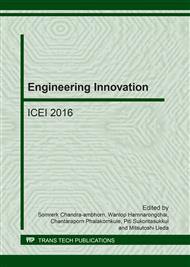p.31
p.36
p.42
p.48
p.54
p.60
p.66
p.72
p.78
Investigation of Thermal Effect on Hot Forging Process of Yoke Flange by Finite Element Modeling
Abstract:
Finite Element Modeling (FEM) has been employed widely to analyze material flow behavior and identify potential defects in a hot forging process before try-out. Normally, the isothermal assumption should be used to simulate this process because the forming time was extremely shot around 0. 5 s – 1 s due to a high velocity of a press machine. However, in some cases when the contact pressure and contact area are extremely high, the heat could significantly dissipate to the forming dies. In case of Yoke flange simulation the isothermal condition could not be used to identify the defect as occurring in the real process. The forging defect (i.e. insufficient gap) was found at the apex of a workpiece in the rough or preform step. In this study, the non-isothermal assumption was used for investigating the defects. The forming process was divided in 3 steps; namely the transportation step when the billet was transferred from an induction furnace to the forging dies by conveyer, the rough forging and the finish forging steps. Temperatures, loads and gaps between workpiece and die at each step of the forming processes were measured and compared with the simulation results. For developing the reliable simulation model, the suitable heat transfer coefficients for each step would be determined. The heat transfer during the forming steps had an effect on the material flow and, the non-isothermal simulation model and could identify the insufficient gap in the rough step.
Info:
Periodical:
Pages:
54-59
Citation:
Online since:
January 2017
Authors:
Price:
Сopyright:
© 2017 Trans Tech Publications Ltd. All Rights Reserved
Share:
Citation:


